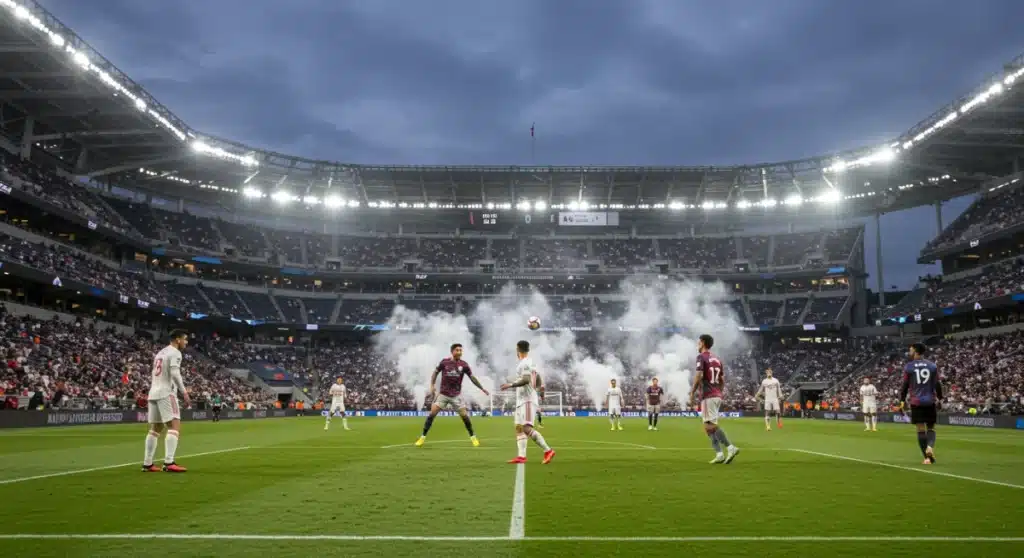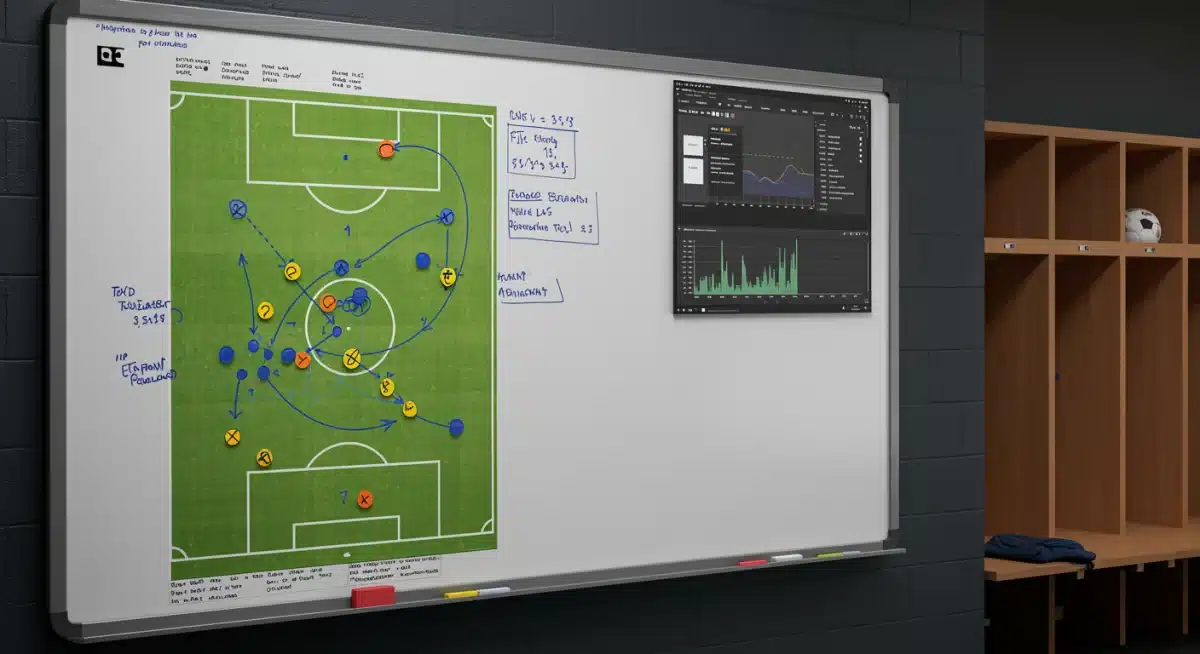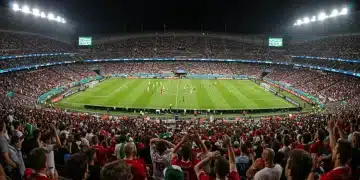MLS 2025: Analyzing 3 Most Effective Tactical Shifts

As the 2025 Major League Soccer (MLS) season unfolds, tactical innovations are reshaping the competitive landscape. This analysis delves into the MLS 2025 Tactical Shifts that are proving most effective, offering a critical look at how teams are adapting and succeeding.
The Resurgence of the 3-4-3 Formation
The 3-4-3 formation, once considered a high-risk strategy, is experiencing a significant resurgence in MLS 2025. Several teams have successfully implemented this system, leveraging its offensive potential and surprising opponents with its adaptability.
This tactical shift prioritizes width and fluid movement in attack, creating numerical overloads in the final third. Defensively, it relies heavily on aggressive wing-backs and a cohesive midfield to cover space and press high.
Key Elements of the 3-4-3 Revival
The successful adoption of the 3-4-3 hinges on specific player profiles and coaching philosophies. Teams like Atlanta United and LA Galaxy have shown how effective this can be when executed with precision.
- Dynamic Wing-Backs: Players capable of relentless up-and-down movement are crucial for both defensive cover and offensive width.
- Pressing Forwards: The front three aren’t just goal scorers; they initiate the press, forcing turnovers high up the pitch.
- Central Midfield Control: A strong pivot in midfield is essential to dictate tempo and recycle possession, protecting the three-man defense.
The 3-4-3 offers a distinct advantage in creating goal-scoring opportunities, often leading to more entertaining and high-scoring matches. Its emphasis on attacking play aligns well with the evolving identity of MLS as a league focused on dynamic football.
High-Intensity Counter-Pressing Systems
Another dominant trend in MLS 2025 Tactical Shifts is the widespread adoption of high-intensity counter-pressing. This strategy, popularized in European leagues, involves immediately pressing the opponent after losing possession, aiming to win the ball back quickly in advanced areas.
This tactical approach demands exceptional fitness levels and coordinated movement from every player on the field. Teams that master counter-pressing can suffocate opponents, preventing them from building attacks and creating sustained pressure.
Implementing Effective Counter-Press
Successful counter-pressing is not merely about running; it requires intelligent positioning and collective understanding. Coaches are dedicating significant training time to drill these complex movements.
- Immediate Reaction: Players must react instantly to a loss of possession, closing down passing lanes and pressuring the ball carrier.
- Coordinated Movement: The entire team moves as a unit, ensuring no player is isolated and all potential outlets are covered.
- Physical Conditioning: The demands of constant pressing require peak physical condition and stamina throughout the entire match.
Teams like Seattle Sounders and Philadelphia Union have demonstrated the efficacy of counter-pressing, turning defensive transitions into offensive opportunities. This shift has led to a noticeable increase in turnovers in midfield and dangerous attacks from quick recoveries.
The Rise of the False Nine and Positional Play
The traditional number nine is becoming a rarer sight in MLS, replaced by the more fluid and tactically astute false nine. This role, often combined with intricate positional play, is one of the most impactful MLS 2025 Tactical Shifts.
A false nine drops deep from the forward line, pulling central defenders out of position and creating space for attacking midfielders or wide forwards to exploit. This movement disrupts conventional defensive structures and offers new avenues for attack.
Advantages of the False Nine Approach
The false nine system, when coupled with a strong understanding of positional play, allows teams to dominate possession and control the tempo of the game. It’s a sophisticated strategy that requires intelligent players.
- Defensive Disruption: Forces center-backs to make difficult decisions, either follow the false nine or hold their position, creating gaps.
- Midfield Overload: The false nine often creates an extra man in midfield, aiding in ball retention and build-up play.
- Passing Network Enhancement: Improves short passing options and allows for quicker ball circulation, breaking down compact defenses.
Orlando City and FC Cincinnati have successfully integrated the false nine, showcasing how this tactical evolution can lead to sustained periods of attacking dominance and create unpredictable scoring threats. This shift emphasizes tactical intelligence over sheer physical presence in the attacking third.

Hybrid Defensive Systems: Adaptability is Key
Beyond offensive innovation, defensive tactics are also evolving significantly in MLS 2025 Tactical Shifts. Hybrid defensive systems, which seamlessly switch between different formations based on the opponent’s possession, are gaining traction. This flexibility allows teams to neutralize various attacking threats.
These systems might start in a 4-4-2 block when defending deep but quickly transition to a 5-3-2 when facing wide attacks or a 4-3-3 when pressing high. The goal is to always maintain numerical superiority or positional advantage in critical areas of the pitch.
Implementing Dynamic Defensive Formations
The success of hybrid defensive systems relies on excellent communication and tactical understanding among players. It demands a high level of discipline and the ability to read the game effectively.
- Situational Awareness: Players must constantly assess the opponent’s positioning and possession to adjust their defensive roles.
- Fluid Transitions: The ability to switch formations quickly and smoothly without losing defensive shape is paramount.
- Versatile Defenders: Players who can comfortably operate in multiple defensive roles are invaluable to these systems.
Teams like Nashville SC and New York City FC have demonstrated how a well-drilled hybrid defensive system can make them incredibly difficult to break down, proving that defensive innovation is as crucial as offensive prowess in modern soccer.
Data Analytics Driving Tactical Decisions
The influence of data analytics on MLS 2025 Tactical Shifts cannot be overstated. Clubs are increasingly relying on advanced metrics and statistical models to inform their tactical decisions, from player recruitment to in-game adjustments.
Data provides insights into opponent weaknesses, player performance trends, and the effectiveness of specific tactical setups. This scientific approach is replacing intuition with evidence-based strategies, leading to more optimized game plans.
Leveraging Analytics for Performance
The integration of data analytics goes beyond simple statistics; it involves complex algorithms and visualization tools that provide actionable intelligence to coaching staff.
- Opponent Scouting: Detailed analysis of opponent passing networks, pressing triggers, and defensive vulnerabilities.
- Player Performance Metrics: Tracking individual player contributions to tactical schemes, including off-ball movement and defensive actions.
- Tactical Effectiveness: Quantifying the success rate of different formations and strategies in various game scenarios.
This data-driven approach allows coaches to tailor their tactics with unprecedented precision, giving them a competitive edge. It’s a continuous feedback loop where performance data informs tactical adjustments, leading to further data collection and refinement.
Emphasis on Player Versatility and Rotational Systems
The demanding schedule and evolving tactical landscape of MLS 2025 have placed a premium on player versatility and rotational systems. Teams are moving away from fixed starting elevens, instead opting for squads with players capable of performing effectively in multiple positions and roles.
This emphasis on versatility allows coaches to implement different tactical approaches without needing to make wholesale changes to their roster. It also helps manage player fatigue and reduces the impact of injuries, ensuring consistent performance throughout a long season.
Benefits of Versatile Squads
A squad rich in versatile players provides coaches with immense tactical flexibility, allowing for in-game adjustments and diverse game plans against different opponents.
- Tactical Flexibility: Enables seamless shifts between formations and strategies, confusing opponents and exploiting their weaknesses.
- Injury Management: Reduces reliance on specific players, allowing for effective rotation and recovery from injuries without significant drop-off in quality.
- Squad Depth: Enhances the overall depth and competitiveness within the squad, as players can cover multiple roles.
Teams that have successfully built versatile squads, such as LAFC and New England Revolution, are demonstrating resilience and adaptability, crucial traits for success in the intensely competitive environment of Major League Soccer.
| Key Tactical Shift | Brief Description |
|---|---|
| 3-4-3 Formation Resurgence | High-risk, high-reward offensive system emphasizing width and attacking overloads. |
| High-Intensity Counter-Pressing | Immediate pressing upon ball loss to regain possession quickly in advanced areas. |
| False Nine & Positional Play | Center forward drops deep, creating space and disrupting traditional defensive lines. |
| Hybrid Defensive Systems | Dynamic defensive formations that adapt based on opponent’s possession and attack. |
Frequently Asked Questions About MLS 2025 Tactical Shifts
The primary goal of the 3-4-3 formation is to create offensive overloads and exploit width, generating numerous goal-scoring opportunities by pushing wing-backs high and having three fluid attackers. It aims for dynamic, high-scoring matches.
High-intensity counter-pressing benefits teams by allowing them to quickly regain possession in dangerous areas of the pitch. This prevents opponents from building attacks and creates immediate offensive transitions, leading to more chances and sustained pressure.
The false nine operates by dropping deep from the attacking line, drawing central defenders out of position. This creates space for teammates to run into and adds an extra player in midfield, improving ball retention and intricate positional play for better offensive flow.
Yes, hybrid defensive systems are increasingly common. They allow teams to dynamically switch between formations based on the opponent’s attacking phase, ensuring constant numerical or positional advantage. This adaptability makes teams much harder to break down.
Data analytics profoundly influences tactical shifts by providing evidence-based insights into opponent weaknesses, player performance, and tactical effectiveness. Coaches use this data to refine game plans, optimize player roles, and make informed decisions, moving beyond traditional intuition.
What Happens Next
The tactical shifts observed in MLS 2025 are not static; they represent an ongoing evolution in how soccer is played at the highest level in North America. As teams continue to refine these strategies, and as new talent emerges, we can expect further innovations. The league’s competitive balance will likely be dictated by which clubs can most effectively adapt to and implement these advanced tactical frameworks, pushing the boundaries of modern soccer and setting new standards for success.





